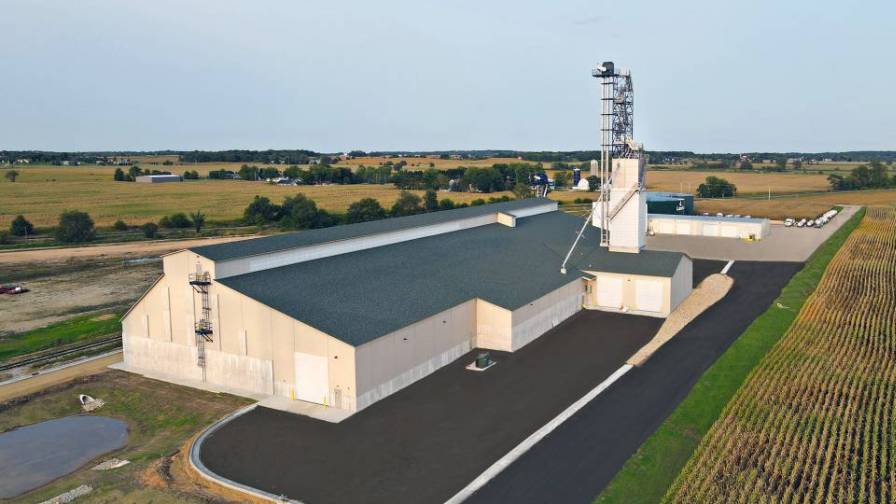U.S. Inland Waterways Need Ongoing Investment to Support Agriculture Trade
The disruptions to barge traffic on the Mississippi River waterway system last year raised concerns in the agriculture community about the potential for future and more frequent impacts resulting from extremely low water levels that restricted barge transits and drove barge freight rates to record highs.
Aging infrastructure, primarily locks and dams, are compounding the challenges to move agriculture goods efficiently and cost effectively.
Tom Torretti, General Manager Sales and Marketing, Consolidated Grain and Barge Co., noted two lock and dams north of St. Louis — Lock and Dam 27 and the Melvin Price Lock and Dam in Alton, IL — are down for repair until March 31st.
Until they reopen, barge traffic must go through an auxiliary chamber, which takes considerably longer than transiting via the main chamber.
In June, three other locks and dams will be shut down through the end of September for major repairs. These include the Marseilles, Dresden Island, and Brandon Road sites.
More than half of all barge trips traverse at least one lock, so when there is a closure the impact on transportation and logistics is significant.
For example, the volume carried by a typical 15-barge tow is equal to that carried by 216 rail cars or 1,050 trucks. Although barge is the slowest mode of transportation, it costs much less, and greenhouse gas emissions are dramatically reduced when compared to road or rail.
When a lock is reopened after a long-term closure, however, “It’s a cluster to end all clusters,” says Torretti.
“You’ll have backlogs and people will want their product. And if they’re harvesting, then they need plenty of empty barges. We’ll get through it, because we always do, but it won’t be easy.”
Torretti says the transportation snags affecting agriculture shipments tend to materialize with road and rail. “When our barges reach their destination and unload there has been trouble finding trucks [for the onward leg of the journey].”
Indeed, the National Grain and Feed Association (NGFA) submitted comments for the House Transportation and Infrastructure Committee hearing on Feb. 1, 2023, urging Congress and the U.S. Surface Transportation Board “to take appropriate action to provide clearer rules to incentivize better rail service and prevent a repeat of rail service failures that escalated in 2022.”
The NGFA stated that, “The impact of unreliable rail service is felt across the NGFA membership, lowering production and increasing the cost of transportation of ethanol, biodiesel, soybean oil, soybean meal, flour, animal feed, meat, and other products derived from grain and feed.”
Furthermore, “Too much of the cost of unreliable and unchallengeable rail service is borne by rail customers, agricultural producers and the general public.”
In addition to rail improvements, the NGFA also wants Congress to add trucking capacity and efficiency by increasing truck weight limits and recommended congressional oversight of the Water Resources Development Act (WRDA) investments to modernize locks and dams.
Torretti credits the U.S. Army Corps of Engineers for “constantly working to take care of the locks and dams, but it’s a work in progress.”
According to a report prepared for USDA’s Agriculture Marketing Service entitled, “Importance of Inland Waterways to U.S. Agriculture,” the 16 locks on the Mississippi River from the northern border of Iowa to the mouth of the Missouri River upriver from St. Louis have an average age of 77 years. On the Illinois Waterway, the locks average nearly 80 years of age, while the locks on the Ohio River were built between 1921 and 2009 and average nearly 55 years of age. Most of the locks have exceeded their 50-year designed and engineered lifespan.
This aging infrastructure has a negative impact on multiple stakeholders along the supply chain, reducing transportation capacity, raising freight rates, and making it tougher for U.S. farmers and the agribusiness sector to compete globally, stated the report.
Analysts from S&P Global noted that last year’s low water levels in the Lower Mississippi River “affected the potential of U.S. corn export due to the record high barge freight cost amid barge transit restrictions. Restrictions were for less cargo per barge and less barges per tow, meaning with lower water levels, vessel operators and shippers have had to use lighter loads because of draft restrictions.”
In the meantime, the Port of South Louisiana is doing its part to invest in infrastructure to support agriculture commodities.
“The Port has prioritized partnering up with industry, especially in the agriculture industry, to seek state and federal grant funding opportunities that can serve as a catalyst for creating efficiencies, foster expansion, and create new jobs,” says Micah Cormier, the Port’s Director of Communications.
“ADM, Cargill, Bunge, and Zen-Noh are all working with our port in some capacity to respond to the food shortage. Additionally, we have invested in improvements at our Globalplex facility that will improve capacity in bulk and liquid cargo movement. Notably, our dock bridge expansion and improvements will flow cargo in and out more safely and faster.”
Cormier added that, “Seven of the state’s nine grain elevators are located in our Port’s jurisdiction, and for the first time in 40 years, a new grain terminal is being constructed in the state of Louisiana,” he says.
“Greenfield Louisiana LLC’s plans for this new, state-of-the-art grain elevator and accompanying dock will facilitate the movement of agricultural goods from both local and national farmers in the U.S. to end users throughout the world.”
Moreover, “With multimodal connectivity in the form of a post-Panamax sized deep-water dock, a tie-in to the main line of the Union Pacific railway, and access to local roads and state and interstate highways, the project will serve to increase the efficiency, reduce the overall environmental impact, and bolster the reliability and resiliency of the U.S. agricultural supply chain, all of which will allow U.S. farmers to better compete in the global economy in a sustainable manner,” says Cormier.






